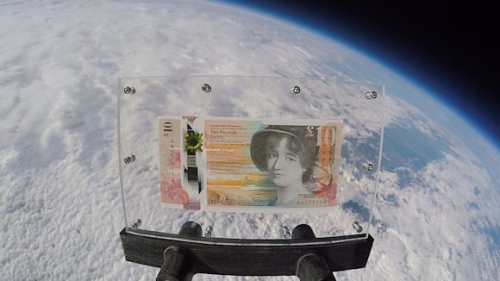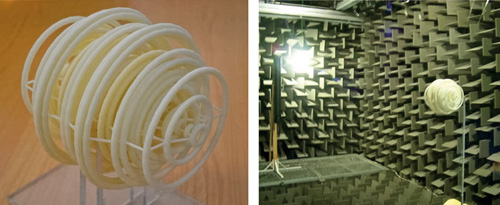Tag archives: acoustics
A tenner in space, why just 0.3% of LIGO bagged the Nobel, sounding-off in Havana
By Hamish Johnston and Matin Durrani
Primary school children in Scotland have celebrated the launch of a new £10 note by launching it into space. Well, sort of. The Royal Bank of Scotland note was actually sent aloft on a high-altitude balloon with a camera to capture the event for posterity.
If you know your astronomers, you will recognize Mary Sommerville on the tenner. She was active in the early 19th century and famously predicted the existence of Neptune by its influence on the orbit of Uranus. She and Caroline Herschel were the first women to be members of the Royal Astronomical Society and she also wrote the bestselling science book On the Connexion of the Physical Sciences.
There is much more about Sommerville in our podcast “Mary, Queen of Scottish banknotes“.
View all posts by this author | View this author's profile
LEGO acoustics, potato cannons go to war, personal politics and popular science
By Hamish Johnston
In the above video Brian Anderson of Brigham Young University shows how the acoustic concept of “time reversal” can be used to knock over a series of LEGO figures using sound. The idea is that sound waves are broadcast into an environment and captured by a sensor at a specific location. The signal is then used to work-out how the sound waves bounced about before reaching the location and this information is then used to target that specific location with subsequent sound waves. In the demonstration, sound knocks over 29 LEGO figures one-by-one. It’s very impressive and entertaining as well.
View all posts by this author | View this author's profile
Can a concert hall have a perfect acoustic?

Sound engineer Paul Waton and soprano Lesley Garrett discussing theatre acoustics at the Royal Opera House. (Courtesy: Brian Slater)
By James Dacey
Concert hall acoustics was the theme of a fascinating panel debate last night at the Royal Opera House (ROH) in London. Among the speakers was British soprano and presenter Lesley Garrett who shared her views on the acoustics of some of the great concert halls in which she has performed. She was joined by acoustics engineer Trevor Cox, acoustics consultant Helen Butcher and sound engineer Paul Waton, who has recorded a range of classical concerts for the BBC. Insight: the Art and Science of Acoustics was co-hosted by the Institute of Physics, which publishes Physics World.
Cox – who featured in our 2014 podcast about sonic wonders – set the scene by describing some of the fundamental acoustic considerations in designing a concert hall. We heard clips of Cox playing a saxophone in an “anechoic” chamber, followed by the same sax lick performed in an oil tanker – the place with officially the longest echo in the world. Cox’s point was to show the difference between high clarity at the one extreme and intense reverberation at the other. The sound wasn’t quite “right” in both cases. “Concert hall design is about finding a pleasing balance between these two extremes,” he said.
View all posts by this author | View this author's profile
Sounding off about valleytronics

Valley state: real-life landscapes can be as beautiful as their condensed-matter counterparts. (CC BY-SA BorisFromStockdale)
By Hamish Johnston
Condensed matter is a physicist’s paradise because of the seemingly endless number of ways that atoms can be rearranged to create systems with new and exciting behaviours. A great example of this is the emerging field of “valleytronics”, which is concerned with a property of electrons that emerges in some semiconductors and 2D materials such as graphene.
The eponymous valley is a local minimum in the conduction band of a solid that “traps” electrons into a specific momentum state. Things get interesting when a material has two valleys that result in two distinct momentum states. In some materials these states resemble the quantum-mechanical property of spin: an electron can be in one of two spin states (up or down) and it can also be in one of two momentum states. As a result, this property is sometimes referred to as valley pseudospin.
View all posts by this author | View this author's profile
How the banjo got its twang, love in the time of science, award-winning astro images and more

Five string banjo showing the position of the bridge on the round head. (CC BY-SA 3.0 / DMacks)
By Tushna Commissariat and Hamish Johnston
Folk and country music often blends the sharp twang of a banjo with the mellow and sustained tone of a guitar. While the two instruments appear to be very similar – at least at first glance – they have very different sounds. This has long puzzled some physicists, including Nobel laureate David Politzer, who may have just solved this acoustical mystery.
View all posts by this author | View this author's profile
Stretching and spinning droplets using sound

Mirror made from tiny polystyrene spheres. (Courtesy: Grzegorczyk et al., Phys. Rev. Lett. 112 023902)
By Hamish Johnston
There are two fantastic papers in Physical Review Letters this week that made me smile. Both of them are about controlling macroscopic objects using waves. While there are practical applications for both techniques, I can’t help thinking that the authors did the work for the sheer joy of it.
View all posts by this author | View this author's profile
Why do beer bottles foam when struck on top?

A foamy mess in the making. (Courtesy: Javier Rodríguez-Rodríguez)
By Hamish Johnston
We’ve all had a friend who does it – you’re deep in conversation at a party, beer bottle in hand, when someone sneaks up and taps the top of your bottle with theirs, causing a foamy mess to erupt from your bottle. And to add insult to injury, their bottle doesn’t foam.
Now, physicists in Spain and France have studied this curious effect and gained a better understanding of how it occurs. While their work won’t prevent wet shoes and slippery floors at university social gatherings, the researchers believe their work could provide insights into geological features such as oil reservoirs, mud volcanoes and “exploding lakes”.
Meet the engineers who talk to aeroplanes

Fancy a chat with this Boeing 787 Dreamliner? (Courtesy: Boeing)
By Ian Randall
For most people, it’s considered rather eccentric to talk to inanimate objects – and if the objects seem to be talking back, then it’s probably time to seek medical advice! Not, however, for Alex Ng and his colleagues at the University of Adelaide in Australia, who are working on a way to “chat” to buildings, bridges, aeroplanes and other structures, so they can report back on their structural health.
View all posts by this author | View this author's profile

